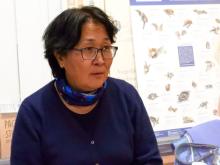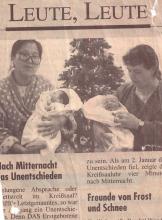On Saturday, 30 November, TUBAF's JuniorUni, a science event especially for children, will take place again. Among others, Bolormaa Dendev will give a lecture. Her topic: How do nomadic children live in Mongolia? Bolormaa Dendev herself comes from Mongolia and studied silicate technology in Freiberg in the 1990s. Today, she heads the scientific liaison office of the Free State of Saxony in Ulaanbaatar. She is also involved in TUBAF's Nomadic Children Project, which equips teachers in rural areas for STEM subjects. We met Bolormaa Dendev ahead of her talk at the JuniorUni in Freiberg. She has already laid out objects on a table that will play a role in her lecture: blue bags that rattle auspiciously.

What can the children expect from your talk at the JuniorUni tomorrow?
We want to talk about how their peers in Mongolia live, how they go to school or what toys they have. And also what festivals we celebrate, in summer and in winter, whether we have Christmas or whether we celebrate it at other times of the year.
The next JuniorUni will take place on 30 November 2024 between 10 am and 1 pm in the Schloßplatzquartier lecture theatre (SPQ-1301), Prüferstraße 4, 09599 Freiberg. First, Christina Seifert, museum educator at terra mineralia, will give the experimental lecture "The stones whispered it...", followed by Bolormaa Dendev with her lecture on the Mongolian nomad children (from 11 a.m.). Registration is not required.
Do people in Mongolia celebrate Christmas?
We don't celebrate Christmas, but we do have a similar family party. We celebrate that in spring, in February or January. Depending on how the moon is calculated. It's called the spring festival after the moon, the white moon festival. Next year, we have our New Year festival on 1 March, which is the White Moon Festival.
So tellus, what's in the sacks?
These are sheep's ankels. I put four of them in each bag to form a game of dice. The ankle has four sides and you roll it like a dice. One side symolises sheep, the other goats, this side is camel and the opposite side of camel is horse. If I roll two identical sides, I hit the second ankle with one and win. This doesn't just work with four knuckles, you play with 100, 200 knuckles. Whoever has collected the most wins. It's something that children like to play in winter when you can't go outside.
What's the biggest difference between a childhood in Germany and a childhood in Mongolia as a nomadic child?
I think it's the closeness to nature. Every child in Mongolia, whether they live in the city or in the countryside, has time to go to their relatives in the summer. The children of the nomads go to the family's summer residence, where they help with farm work and play with the animals. They also learn to love the animals. They have their own horses or their own sheep and goats. They develop together with nature. We are only second generation city dwellers. That means that people who live in the city also have relatives in the countryside.
How did the nomadic children project kick off?
We have visited two schools in the countryside so far and carried out small experiments with the children, using very simple means to explain physics, chemistry and maths and teach the children that STEM subjects are nothing terrible.
Did you also approach the teachers?
First of all, we reached out to the head teachers and then indidual classes. They were very pleased that we then came with simple resources and explained to the children that there doesn't necessarily have to be expensive labs and equipment to know about these subjects.

You studied in Freiberg. How do you feel about coming back here?
I'm coming home. Really (laughs). When I'm in Freiberg, I'm at home. When I go to Mongolia, I'm also at home. But here, too. It all feels familiar to me. Growing up from a young girl to an adult, that all happened here. I have many memories associated with Freiberg. My eldest son was born here. He was the first child born on New Year's Day in 1995 and we made to the newspaper.
When I went into the examinations office in March, they all congratulated me on the new arrival. When my son was tow years old, he went back to Mongolia with my mum so that I could finish my studies. He has not visited Freiberg ever since. I did however bring three stones from the park with me as a reminder of Freiberg. It gives my son strength and energy when he takes stones from his birthplace with him. So he always takes these three stones. That's our custom (laughs). The stones are a source of energy for him in difficult situations. If he wants to find a solution, he picks up the three stones.